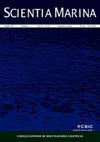Coexistence of the reef-building coral Cladocora caespitosa and the canopy-forming alga Treptacantha ballesterosii: Description of a new Mediterranean habitat
IF 0.9
4区 生物学
Q4 MARINE & FRESHWATER BIOLOGY
引用次数: 3
Abstract
espanolLos ambientes rocosos someros del Mediterraneo estan habitualmente dominados por macroalgas, no obstante, el coral colonial zooxantelado Cladocora caespitosa es capaz de formar bancos extensos en algunos lugares. Aunque es predecible que los corales con zooxantelas y las algas bentonicas compitan por la luz y el espacio cuando coinciden en el mismo habitat, hay evidencias previas de que C. Caespitosa y las algas mediterraneas no se excluyen competitivamente cuando viven juntas. En este trabajo se caracteriza un nuevo y unico habitat mediterraneo donde el coral formador de arrecifes C. caespitosa y algas erectas del orden Fucales (Cystoseira s.l.) coexisten. En este habitat nuevo C. Caespitosa alcanza coberturas del 34% y las densidades de Cystoseira s.l. (principalmente de Treptacantha ballesterosii) son mucho mayores que los valores encontrados en otros lugares. Remarcablemente, las abundancias de T. Ballesterosii y C. Caespitosa muestran una relacion positiva, sugiriendo que existe algun tipo de mecanismo de facilitacion. Este hallazgo pone en jaque la teoria de exclusion competitiva entre corales y macroalgas, a la vez que puede iniciar un amplio abanico de discusiones en las interacciones entre corales y macroalgas. EnglishShallow Mediterranean rocky environments are usually dominated by macroalgae, but the stony colonial zooxanthellate coral Cladocora caespitosa is able to build extensive banks in some particular areas. Although zooxanthellate corals and benthic macroalgae are expected to compete for light and space when overlapping in the same habitat, there is previous evidence that C. Caespitosa and Mediterranean macroalgae do not suffer from competitive exclusion when living together. Here we characterize a new and unique Mediterranean habitat where the reef-building coral C. Caespitosa and erect seaweeds of the order Fucales (Cystoseira s.l.) coexist. In this new habitat C. Caespitosa reaches 34% cover and densities of Cystoseira s.l. (mainly Treptacantha ballesterosii) are much higher than values reported from other sites. Interestingly, abundances of T. Ballesterosii and C. Caespitosa show a positive relationship, suggesting that some kind of facilitation mechanism is taking place. These findings challenge the theory of competitive exclusion between corals and macroalgae and launch a wide array of possible open discussions on coral-macroalgae interactions.造礁珊瑚Cladocora caespitosa和遮篷藻类Treptacanta ballesterosii的共存:一个新的地中海栖息地的描述
地中海的浅层岩石环境通常以大型藻类为主,然而,在某些地方,动物黄体枝角珊瑚能够形成广阔的海岸。虽然带有动物黄原菌和膨润土藻类的珊瑚在同一栖息地相遇时可以预先竞争光和空间,但以前有证据表明,当它们生活在一起时,凯撒皮托萨和地中海藻类并没有被竞争性地排除在外。在这项工作中,它的特点是一个新的和独特的地中海栖息地,在那里形成珊瑚礁的珊瑚和岩藻目的直立藻类(Cystoseira S.L.)共存。在这个新的栖息地中,Caespitosa的覆盖率达到34%,Cystoseira S.L.(主要来自Treptacantha ballesterosii)的密度远高于其他地方发现的值。值得注意的是,Ballesterosii和Caespitosa的丰度呈正相关,表明存在某种促进机制。这一发现质疑了珊瑚和大型藻类之间的竞争排斥理论,同时也可能引发关于珊瑚和大型藻类之间相互作用的广泛讨论。英国浅地中海岩石环境通常以大型藻类为主,但石质殖民地Zooxan-Thellate Coral Cladocora caespitosa能够在某些特定地区建立广泛的银行。虽然当在同一栖息地重叠时,预计动物黄原酸盐珊瑚和底栖大型藻类将争夺光和空间,但有先前的证据表明,C.凯撒皮托萨和地中海大型藻类在共同生活时不会受到竞争性排斥。在这里,我们描述了一个新的独特的地中海栖息地,在那里,珊瑚礁建筑珊瑚C.Caespitosa和Fucales目直立海草(Cystoseira S.L.)共存。在这个新的栖息地中,Caespitosa的覆盖率达到34%,Cystoseira S.L.(主要是Treptacantha ballesterosii)的密度远高于其他地方报告的值。有趣的是,T.Ballesterosii和C.Caespitosa的丰富性显示出积极的关系,表明正在建立某种促进机制。这些发现挑战了珊瑚和大型藻类之间竞争排斥的理论,并启动了一系列关于珊瑚-大型藻类相互作用的可能公开讨论。
本文章由计算机程序翻译,如有差异,请以英文原文为准。
求助全文
约1分钟内获得全文
求助全文
来源期刊

Scientia Marina
生物-海洋与淡水生物学
CiteScore
2.10
自引率
0.00%
发文量
21
审稿时长
6-12 weeks
期刊介绍:
Scientia Marina is the successor to Investigación Pesquera, a journal of marine sciences published since 1955 by the Institut de Ciències del Mar de Barcelona (CSIC). Scientia Marina is included in the Science Citation Index since 1998 and publishes original papers, reviews and comments concerning research in the following fields: Marine Biology and Ecology, Fisheries and Fisheries Ecology, Systematics, Faunistics and Marine Biogeography, Physical Oceanography, Chemical Oceanography, and Marine Geology. Emphasis is placed on articles of an interdisciplinary nature and of general interest.
 求助内容:
求助内容: 应助结果提醒方式:
应助结果提醒方式:


